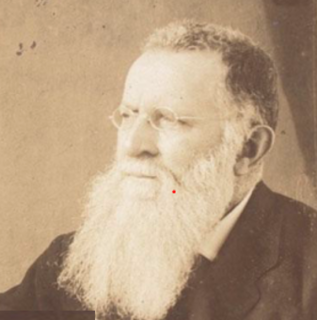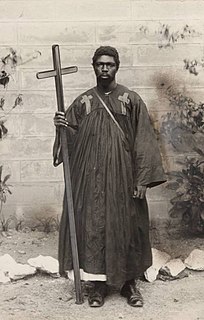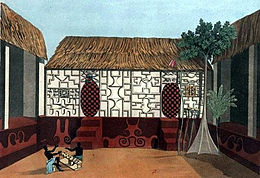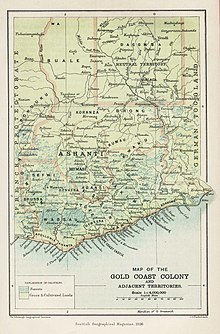
Abomey is the capital of the Zou Department of Benin. The commune of Abomey covers an area of 142 square kilometres and, as of 2012, had a population of 90,195 people.

Sudano-Sahelian architecture refers to a range of similar indigenous architectural styles common to the African peoples of the Sahel and Sudanian grassland (geographical) regions of West Africa, south of the Sahara, but north of the fertile forest regions of the coast.

The Akan are a meta-ethnicity living primarily in the countries of present-day Ghana and Ivory Coast in West Africa. The Akan language are a group of dialects within the Central Tano branch of the Potou–Tano subfamily of the Niger–Congo family. Subgroups of the Akan people include: the Agona, Akuapem, Akwamu, Akyem, Ashanti, Bono, Fante, Kwahu, Wassa, and Ahanta. The Akan subgroups all have cultural attributes in common; most notably the tracing of matrilineal descent, inheritance of property, and succession to high political office.

The Ashanti Region is located in south Ghana and it is the third largest of 16 administrative regions, occupying a total land surface of 24,389 km2 (9,417 sq mi) or 10.2 percent of the total land area of Ghana. In terms of population, however, it is the most populated region with a population of 4,780,380 according to the 2011 census, accounting for 19.4% of Ghana's total population. The Ashanti Region is known for its major gold bar and cocoa production. The largest city and regional capital is Kumasi.

The Golden Stool is the royal and divine throne of kings of the Ashanti people and the ultimate symbol of power in Asante. According to legend, Okomfo Anokye, High Priest and one of the two chief founders of the Asante Confederacy, caused the stool to descend from the sky and land on the lap of the first Asante king, Osei Tutu. Such seats were traditionally symbolic of a chieftain's leadership, but the Golden Stool is believed to house the spirit of the Asante nation—living, dead and yet to be born.

Jongmyo is a Confucian shrine dedicated to the perpetuation of memorial services for the deceased kings and queens of the Korean Joseon Dynasty (1392–1897). According to UNESCO, the shrine is the oldest royal Confucian shrine preserved and the ritual ceremonies continue a tradition established in the 14th century. Such shrines existed during the Three Kingdoms of Korea period (57–668), but these have not survived. The Jongmyo Shrine was added to the UNESCO World Heritage list in 1995.

The Djinguereber Mosque in Timbuktu, Mali is a famous learning center of Mali built in 1327, and cited as Djingareyber or Djingarey Ber in various languages. Its design is accredited to Abu Ishaq Al Saheli who was paid 200 kg of gold by Musa I of Mali, emperor of the Mali Empire. According to Ibn Khaldun, one of the best known sources for 14th century Mali, al-Sahili was given 12,000 mithkals of gold dust for his designing and building of the djinguereber in Timbuktu. But more reasoned analysis suggests that his role, if any, was quite limited. The architectural crafts in Granada had reached their zenith by the fourteenth century, and it is extremely unlikely that a cultured and wealthy poet would have had anything more than a dilettante's knowledge of the intricacies of contemporary architectural practice.

The Akyem are an Akan people. The term Akyem is used to describe a group of four states: Asante Akyem, Akyem Abuakwa, Akyem Kotoku and Akyem Bosome. These nations are located primarily in the eastern region in south Ghana. The term is also used to describe the general area where the Akyem ethnic group clusters. The Akyem ethnic group make up between 3-4 percent of Ghana's population depending on how one defines the group and are very prominent in all aspects of Ghanaian life. The Akyem are a matrilineal people. The history of this ethnic group is that of brave warriors who managed to create a thriving often influential and relatively independent state within modern-day Ghana. When one talks of Ghanaian history, there is often mention of The Big Six. These were six individuals who played a big role in the independence of Ghana. Of the big six, people of Akyem descent made up the majority.

The Asante Empire, today commonly called the Ashanti Empire, was an Akan state that lasted between 1701 to 1901, in what is now modern-day Ghana. It expanded from the Ashanti Region to include most of Ghana as well as parts of Ivory Coast and Togo. Due to the empire's military prowess, wealth, architecture, sophisticated hierarchy and culture, the Ashanti Empire has been extensively studied and has more historic records written by European, primarily British authors than any other indigenous culture of Sub-Saharan Africa.

The Asante, also known as Ashanti, are part of the Akan ethnic group and are native to the Ashanti Region of modern-day Ghana. Asantes are the last group to emerge out of the various Akan civilisations. Twi is spoken by over nine million Asante people as a first or second language.

The Royal Palaces of Abomey are 12 palaces spread over an area of 40 hectares at the heart of the Abomey town in Benin, formerly the capital of the West African Kingdom of Dahomey. The Kingdom was founded in 1625 by the Fon people who developed it into a powerful military and commercial empire, which dominated trade with European slave traders on the Slave Coast until the late 19th century, to whom they sold their prisoners of war. At its peak the palaces could accommodate up to 8000 people. The King's palace included a two-story building known as the "cowrie house" or akuehue. Under the twelve kings who succeeded from 1625 to 1900, the kingdom established itself as one of the most powerful of the western coast of Africa.

The Manhyia Palace is the seat of the Asantehene of Asanteman, as well as his official residence. It is located at Kumasi, the capital of the Ashanti Region. The first palace is now a museum. Otumfuor Opoku Ware II built the new palace, which is close to the old one and is used by the current Asantehene, Otumfuor Osei Tutu II.

Prempeh II, was the 14th Asantehene, or king of the Ashanti, reigning from 22 June 1931 to 27 May 1970.

Offinso, is a town in the Offinso Municipality in the Ashanti Region of Ghana. The town is about fifteen minutes drive from Kumasi, the capital of the Ashanti Region; due to Offinso's proximity to Kumasi, many of the Offinso natives have relocated to Kumasi.

Friedrich Augustus Louis Ramseyer also Fritz Ramseyer was a Swiss-born Basel missionary, who was captured by the Asante in 1869 in colonial Ghana, together with his wife Rosa Louise Ramseyer, Basel mission technical staff, Johannes Kühne and French trader, Marie-Joseph Bonnat. Ramseyer was later released in 1874 and pioneered the Christian mission in Kumasi and the rest of Asante. Additionally, he spearheaded the planting of churches in Abetifi. Apart from his evangelism, Ramseyer was instrumental in the expansion of opportunities in the fields of education, artisan industry training, land acquisition for building design and manpower development in the areas he lived and worked in.

Samson Kwame Oppong also Sampson Opon or Opong was a controversial Akan Christian preacher-prophet on the Gold Coast in the 1920s. His missionary zeal, unconventional and fiery ministry helped entrench Methodism in the Ashanti and Brong-Ahafo Regions of Ghana, through a large-scale spiritual awakening and revival. Though his knowledge of Christian theology was minimal, he is known to have employed threats and other coercive techniques to proselytise in the Ghanaian towns and villages he worked in.
Yaa Asantewaa Festival is an annual festival celebrated by the chiefs and peoples of Ejisu Traditional Area in the Ashanti Region of Ghana. It is usually celebrated in the month of August.

The Ashanti Empire was governed by an elected monarch with its political power centralised. The entire government was a federation. By the 19th century, the Empire had a total population of 3 million. The Ashanti society was matrilineal as most families were extended and were headed by a male elder who was assisted by a female elder. Asante twi was the most common and official language. At its peak from the 18th–19th centuries, the Empire extended from the Komoé River in the West to the Togo Mountains in the East.
Ghana was initially referred to as the Gold Coast. After attaining independence, the country's first sovereign government named the state after the Ghana Empire in modern Mauritania and Mali. Gold Coast was initially inhabited by different states, empires and ethnic groups before its colonization by the British Empire. The earliest known physical remains of the earliest man in Ghana were first discovered by archaeologists in a rock shelter at Kintampo during the 1960s. The remains were dated to be 5000 years old and it marked the period of transition to sedentism in Ghana. Early Ghanaians used Acheulean stone tools as hunter gatherers during the Early stone age. These stone tools evolved throughout the Middle and Late Stone Ages during which some early Ghanaians inhabited caves.



















